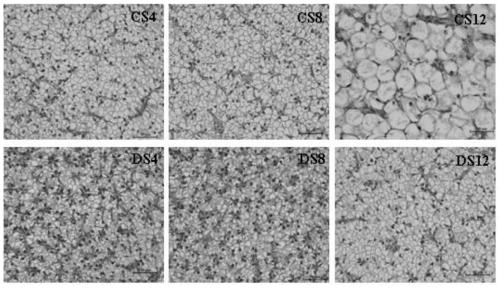Compound feed for relieving liver glycogen accumulation of micropterus salmoides and preparation method of compound feed
A technology for compound feed and perch liver sugar is applied in the field of compound feed for relieving the accumulation of liver glycogen in largemouth bass and its preparation field, so as to achieve the effects of improving feeding performance, reducing accumulation and blood sugar content, and increasing starch content
- Summary
- Abstract
- Description
- Claims
- Application Information
AI Technical Summary
Problems solved by technology
Method used
Image
Examples
Embodiment 1
[0055] The specific steps for preparing enzymatic starch are as follows:
[0056] Tapioca starch was selected as the starch source, and a 20% tapioca starch solution was prepared with sodium acetate buffer solution (pH 4.5). After thorough stirring, it was placed in an autoclave for gelatinization at 120°C for 10 minutes and cooled to room temperature to obtain a starch paste 化液. Then add pullulanase (1350NPUN / g) at the ratio of 6g / kg, enzymatically hydrolyze at 55℃, pH4.5 for 8h, then boil water bath for 10min to inactivate the enzyme, cool naturally and store at 4℃ for 24h, 60 Blast drying at ℃ for 26h, crushed and passed through 80 mesh sieve to obtain enzymolyzed starch.
[0057] It was determined that the amylose content of the obtained enzymatic starch was 28.21%, which was 30.0% higher than the tapioca starch before treatment; the resistant starch content was 14.22%, which was 299.4% higher than the tapioca starch before treatment.
Embodiment 2
[0059] Through gradient addition of α-cassava starch and the enzymatic starch prepared in Example 1 (addition amounts are 4%, 8% and 12% respectively), six kinds of compound feeds with equal nitrogen (51%) and fat (11%) are prepared. The formula is shown in Table 1. All low-fat raw materials are passed through an 80-mesh sieve, and are mixed uniformly according to the feed formula according to the step-by-step mixing method. The mixed soybean oil and soybean phospholipid are mixed with the above mixture evenly and passed through a 40-mesh sieve. A 40-mesh sieve was passed through the 2.5mm die hole of the granulator for granulation, then gelatinized in an oven at 105°C for 15 minutes, and dried in an oven at 55°C. After drying, store the feed in a refrigerator at -20°C for later use.
[0060] Table 1: Experimental feed formula
[0061]
[0062] The present invention also provides the application of the enzymatic starch prepared in Example 1 in reducing liver glycogen accumulation...
Embodiment 3
[0064] Using the compound feed prepared in Example 2, the largemouth bass with an initial weight of 13.08±0.02g was selected as the experimental object, and a 12-week breeding experiment was carried out in a recirculating aquaculture system, with 3 replicates for each treatment and 40 for each replicate. Tail fish. The effects on growth, visceral index, liver glycogen content, postprandial blood glucose and liver histology of largemouth bass were determined. The experimental data is expressed by the mean ± standard error, and SPSS19.0 analysis software is used for two-way analysis of variance. The significance of the difference between fixed factors is determined by Turkey's test method, and P <0.05 is the significant level.
[0065] Table 2: Experimental breeding results of each group
[0066]
[0067] Note: In the two-factor analysis, n.s. means that the difference is not significant; the difference between starch types is significant with *.
[0068] It can be seen from Table 2 ...
PUM
 Login to View More
Login to View More Abstract
Description
Claims
Application Information
 Login to View More
Login to View More - R&D
- Intellectual Property
- Life Sciences
- Materials
- Tech Scout
- Unparalleled Data Quality
- Higher Quality Content
- 60% Fewer Hallucinations
Browse by: Latest US Patents, China's latest patents, Technical Efficacy Thesaurus, Application Domain, Technology Topic, Popular Technical Reports.
© 2025 PatSnap. All rights reserved.Legal|Privacy policy|Modern Slavery Act Transparency Statement|Sitemap|About US| Contact US: help@patsnap.com



